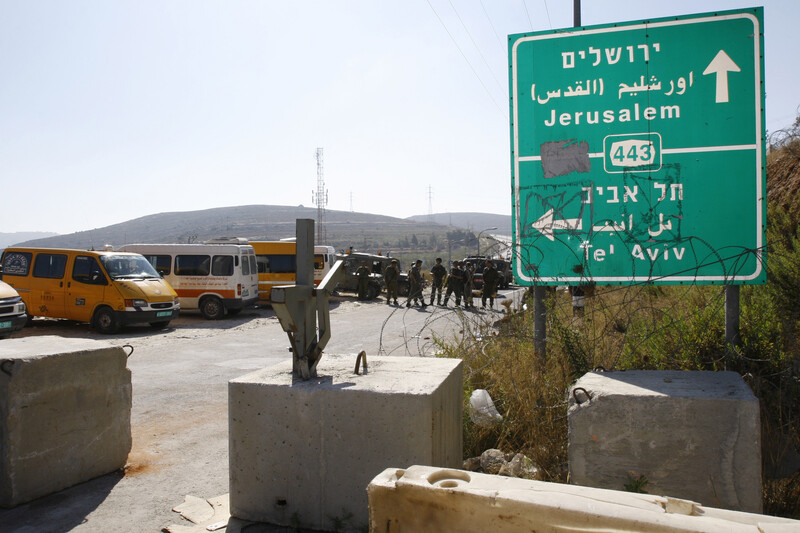Rights and Accountability 21 May 2014

Decades ago Israel claimed to be building Route 443 for Palestinians’ benefit; today only Israelis can travel on it.
ActiveStillsBy ruling that settlers are part of the local population in the West Bank who need protection, the Israeli high court abuses the international law which it invokes — law intended to protect the occupied Palestinian population, not the colonizing, occupying power. And by legitimizing Israel’s settler policies and practices, the court has paved the way for two sets of laws for two populations, thus contributing further to a situation of apartheid.
Such are the conclusions of international law expert Sharon Weill, who analyzed numerous high court rulings in disputes in the occupied West Bank for her new book The Role of National Courts in Applying International Humanitarian Law, which evaluates how various domestic courts — such as those in Israel, Serbia, the UK, the US, Canada and Italy — have interpreted and applied international humanitarian law.
The international law of occupation is based on the assumption that an occupation is a temporary situation which lasts until a political agreement is reached, and promotes the maintenance of the status quo in the occupied territory.
The Israeli high court reviews the legality of decisions and acts of the State of Israel, its agencies and the armed forces, including the military commander in the occupied West Bank and Gaza Strip.
Since 1970, the Israeli high court has applied the Hague Regulations of 1907, and thus Israel considers itself bound to the rules of occupation. Article 43 of the regulations states that local law of the occupied territory should remain in force and also restricts the occupying force to introducing changes to the status quo only when absolutely necessary.
In the case of Israel’s occupation of the West Bank and Gaza Strip, such changes should serve the Palestinians. But, Weill argues, instead of protecting the civil, social and economic rights of the occupied Palestinians, the Israeli high court has legitimized the creation of settlements and a segregation regime in the occupied West Bank. Moreover, the court has provided Israel with the necessary legal tools to further design and implement this regime.
Settler roads
Weill highlights some striking examples to underpin her conclusions, for example the case of settler roads in the West Bank.
In the 1983 Jamiat Ascan case mentioned in the book, Palestinian land owners from the West Bank petitioned the high court against the confiscation of their land for the construction of new roads which would connect Israel to the West Bank. The petitioners claimed that the military authority had no right to expropriate their land because the roads were not intended to serve the local Palestinian population; instead, the roads would serve Israeli residents traveling from Israel to the West Bank, including Jerusalem. The Palestinian landowners argued that the military commander had no authority to introduce such permanent changes that would last beyond the occupation.
But the Israeli high court set a precedent to allow just that, Weill shows. In 1983, Justice Aharon Barak approved the expropriation of the Palestinian land needed for the roads, accepting the Israeli government’s argument that the military commander in the West Bank had the duty to ensure public order and civil life as a “modern and civilized state of the twentieth century” which required new long-term projects that could involve permanent changes. Justice Barak rejected the status quo approach, ruling that new laws and long-term changes can be introduced for two reasons: to meet the security needs of the occupying power or the welfare of the local population.
However, as Weill points out, Justice Barak’s interpretation differs from the actual wording of Article 43, which imposes the obligation to restore and ensure public order and civil life while — unless absolutely prevented — respecting the local law.
According to international law, the military commander in the West Bank is not allowed to act in the economic or social interests of Israel alone. These interests can only be secondary conditions. But Barak decided that the road could not be illegal, arguing that it primarily served the interests of the occupied Palestinians. The high court approved the land expropriation and Route 443 was built.
Protecting settlers, not Palestinians
Barak further introduced in his ruling invaluable advice to the state by pointing out that it was curious that the “security need” to build these roads was not mentioned in the government’s argument. Indeed, Israel is responsible for providing security in the territory it occupies, according to Article 43. But in Barak’s ruling, the court transformed the article that authorizes changes for security needs of the occupying power forces when absolutely necessary into a provision that permits changes for security reasons, paving the way to a broad interpretation of the term “security reasons” to include all kind of situations.
For example, as Weill shows, in the Maraabe case in which Palestinians petitioned against the construction of the Israel wall around the West Bank village of Qalqiliya in order to “protect” a nearby settlement colony, Israel claimed Article 43 obliges the state to protect the Israeli settlements although the settlements were established in violation of international law. Meanwhile, the International Court of Justice’s 2004 advisory opinion on Israel’s wall in the West Bank leaves no doubt about the illegality of the Israeli settlements built on occupied Palestinian land.
By accepting the government’s claims and perverting international law, the high court provides the legal tools to pave way for settlement expansion under the guise of ensuring security.
Apartheid Route 443
The Palestinian land that was confiscated for the construction of a modern system of roads purportedly for the benefit of the local Palestinian population decades ago only served the Israeli population in the end.
At present, an estimated 40,000 Israeli residents use Route 443 on a daily basis. After several attacks on Israeli vehicles in 2000, according to Weill’s book, Palestinians were increasingly prevented from using the road. By 2002, Israel turned it into an Israelis-only road by physically closing off the road for Palestinians with iron gates, concrete blocks or checkpoints. An absolute travel ban for Palestinian vehicles on Route 443 was introduced by a military order in August 2007.
Weill recounts how the Association of Civil Rights in Israel petitioned the high court in 2007 for the closure of Route 443, arguing that the state policy amounted to an exercise of apartheid. Although the road is mostly built within the occupied West Bank, the court took into consideration not only the security of the settlers but that of all Israeli drivers. The high court ruled that Israeli citizens are entitled to move freely within the occupied West Bank and the military commander is under the obligation – according to Article 43 – to ensure their security. Therefore the freedom of movement of the Palestinians may be limited in a proportional way, the court argued.
Through these and other examples, Weill convincingly shows that the court has abused international law to legitimize the colonization policies of the State of Israel. It is clear that in Israel’s case, the high court has taken on the apologist role and has become the legitimating agency for the actions of the state.





